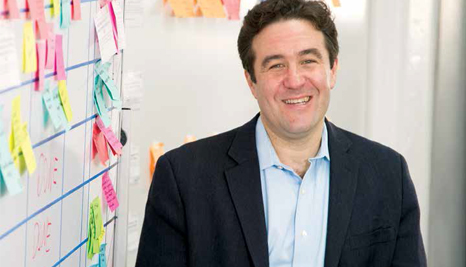The Kalamazoo Promise provides college scholarships to graduates of Kalamazoo Public Schools (KPS), a midsized urban school district in Michigan that is racially and economically diverse. Anonymous donors promise to pay up to 100 percent of college tuition for any KPS graduate who attends a public college or university in Michigan. Scholarships start at 65 percent of college tuition for students who enrolled in KPS in 9th grade and stay until graduation, and increase to 100 percent for students who have attended since kindergarten. The scholarship is not limited to students with strong academic records or demonstrated financial need. Students must simply get into college and maintain a 2.0 grade-point average (GPA) while enrolled. Announced in 2005, the Kalamazoo Promise is unusual among scholarship programs in its universality and generosity.

As a model for revitalizing an urban school district and its community, the Promise, as it is called, has attracted much attention and many imitators. At least 24 other areas around the country have launched or are trying to launch Promise-style programs, with private or public funding. In part because of the Promise, President Obama delivered the commencement address to the graduating class of Kalamazoo Central High School in 2010.
Given the popularity and cost of the programs, there is a need for research to determine the size of the benefits of Promise-style efforts, or indeed, whether there are any discernible benefits. The tuition subsidies available through the Promise should create incentives for higher academic performance. Students who might otherwise attend Western Michigan University (WMU), the state campus located in Kalamazoo, may use the tuition subsidy to enroll at higher-ranked schools such as Michigan State University or the University of Michigan. Students who would otherwise have attended the local community college may use the subsidy to matriculate at WMU. And students who without the Promise might not have attended college at all may take advantage of the benefit to go to a community college. Previous research suggests that the Promise has in fact increased interest among eligible KPS graduates in enrolling at Michigan’s flagship schools.
Because admission to and graduation from more-demanding colleges requires students to have stronger academic preparation, the tuition benefits of the Promise also have the potential to encourage students to work harder and achieve more in high school. Yet despite the Promise’s incentives for improving performance, students may not respond as hoped. Some students may view the Promise’s benefits as too uncertain and too delayed, and students who want to improve their academic performance may not know how to do so.
Our study takes advantage of the unexpected announcement of the Kalamazoo Promise to study its effects on student achievement and behavior in high school. Specifically, we examine how the achievement and behavior of individual students eligible for a tuition subsidy changed after the program was launched. We find clear evidence that the Promise reduced student behavior problems. Our results on academic performance for all students are unfortunately not precise enough to draw strong conclusions. Even though our estimates of the program’s impact are not statistically significant, we cannot rule out the possibility of substantial positive effects. For African American students, however, the Promise both improved behavior and had a dramatic positive effect on high school GPAs.
Kalamazoo Public Schools
A predominantly urban school system, the Kalamazoo Public Schools have faced declining enrollment for many years. This reflects, in part, the modest pace of economic growth in Michigan and Kalamazoo. It also reflects the Kalamazoo district’s location in a center city that has more economic problems than the surrounding metropolitan area. For example, family poverty rates as of the 2000 census were 13.6 percent in the city of Kalamazoo and 6.5 percent in all of Kalamazoo County.
The Kalamazoo school district has historically had many low-income students and students from diverse ethnic backgrounds. In the years before the Promise was announced, although KPS retained a considerable percentage of white students and students who did not qualify for free or reduced-price lunch, the percentage of both groups of students was falling. Since the advent of the Kalamazoo Promise, KPS enrollment has been on the rise. Furthermore, enrollment has climbed proportionately for all ethnic groups, so the ethnic percentages have stabilized (see Figure 1). Previous studies indicate that these patterns reflect a large one-time increase in the number of students entering KPS the year following the Promise’s announcement, accompanied by a permanent decline in the exit rate among students already enrolled.

The Kalamazoo Promise was funded by anonymous donors who, according to the school district, had three primary goals: 1) to promote local economic and community development, in part by attracting parents and businesses to the Kalamazoo area; 2) to boost educational achievement and attainment; and 3) to increase confidence in KPS.
The Promise is available to all students who reside in the district, graduate from KPS, and have been KPS students for four years or longer. The scholarship must be used within 10 years of high school graduation. The size of the benefit depends on the length of continuous enrollment in the KPS system. The Promise covers 100 percent of all tuition costs and mandatory fees for up to four years for students who enrolled in KPS in kindergarten. For those who enrolled in grades 1 through 3, the scholarship covers 95 percent of those costs. The tuition benefit decreases by 5 percent per year as the number of years of continuous enrollment declines, covering 65 percent of costs for those enrolling in 9th grade. A student entering KPS in grade 10 or afterward is ineligible for Promise tuition benefits.
Other than onset of continuous enrollment, no aspect of a student’s K–12 experience or family background affects eligibility. Students do not have to demonstrate financial need, maintain any minimum GPA in high school, or take any particular mix of courses. Students obviously need to gain admission to a Michigan college, however, to receive Promise benefits.
The scholarship is available to all students who are admitted to and enroll at any public university or community college in the state of Michigan. The students must attend full time (defined as a minimum of 12 credit hours) and maintain a 2.0 GPA while in college. Students who fall below a 2.0 GPA can become eligible again for the Promise if they continue attending college on their own (or their family’s) dime and succeed in increasing their cumulative GPA above the 2.0 threshold. Students are eligible for Promise benefits for up to 130 credits of undergraduate college or university education, typically enough to complete a four-year degree program. The Promise’s benefits can be applied to certificate programs at community colleges, in addition to programs leading to an associate or bachelor’s degree.
The Kalamazoo Promise has been widely used. Between 80 and 90 percent of KPS graduates have been eligible for at least some Promise benefits. Of those eligible, between 82 and 85 percent at some point have taken advantage of their benefits. We estimate that the total value of the scholarship for a typical student over four years ranges from about $18,000 with the 65 percent benefit to about $27,000 at the 100 percent benefit. These averages include enrollment at colleges with very different prices, in the case of the 100 percent benefit, ranging from under $5,000 for four years of tuition at the least costly option (Kalamazoo’s local community college) to more than $55,000 at the most expensive (the University of Michigan).

Data and Methodology
Our data come from KPS administrative records. We focus our analysis on high school students for several reasons. First, it allows the analysis to include students who are ineligible for the Promise because they entered after 9th grade and can therefore serve as a comparison group for eligible students. Second, for high school students rather than younger students, the tuition benefits of the Kalamazoo Promise are closer in time. Third, high school students are more likely than younger students to believe that their achievement and behavior in school will affect their admission prospects at more-selective colleges.
We examine data on 9th- through 12th-grade students from the school years 2003–04 to 2007–08. This period includes two pre-Promise school years, the year the Promise scholarship was announced, and two post-Promise school years. The information we have on each student includes demographic characteristics, credits completed, grade-point averages, and disciplinary actions, including days of suspension and detention.
In each year, we calculate for each student what the Promise subsidy would have been had the Promise been in effect for that year and had the student continued attending KPS until graduation. We call this the student’s “virtual Promise benefit,” which in 2003–04 and 2004–05 was indeed virtual in the sense that the student was unaware of it, as the Promise was not announced until November 2005. Therefore, we would assume that any effect of this simulated Promise benefit before 2005 reflects consequences that are associated with the grade level in which the student entered KPS rather than the effect of a Promise benefit of which the student had no knowledge.
On November 10, 2005, students became aware of the potential Promise benefits that would accrue to them given their enrollment in KPS to date. It is possible that Promise benefits had some effect on student achievement and behavior starting on that date. However, it would also be reasonable to assume that it took some time for students to understand and respond to the incentives of the Promise. By November 2005, students had already made certain decisions about that academic year, such as what courses to enroll in for fall 2005. When the first full post-Promise year began in fall 2006, students may have more fully understood what the program might mean for their future.
We measure the effect of the Promise by comparing the achievement and behavior of students before and after they became aware of their benefits. For example, students who were enrolled in KPS since kindergarten found themselves eligible for a 100 percent tuition scholarship after the Promise was announced. We examine whether their achievement and behavior improved more after they learned of the scholarship than that of students who did not become eligible for a scholarship because they had enrolled in KPS much later. This comparison amounts to a natural experiment, because whether students became eligible for a scholarship was determined by enrollment decisions their families made without knowledge of the Promise.
Because of their enrollment status in KPS, the overwhelming majority of students who are eligible for any benefit are eligible for a benefit of 80 percent or more of college tuition. This suggests that it would be difficult to make fine distinctions for students in different tuition-subsidy groups. In addition, it is unclear whether the difference between a 65 percent subsidy and greater subsidies is salient for most high-school students. We therefore focus on differences in academic achievement and behavior between Promise-eligible and -ineligible students, before and after the Promise was announced.
By comparing changes in the behavior and achievement of eligible and ineligible students, our analysis is likely to understate the overall effects of the Promise because it will not capture any effects on ineligible students. For example, if eligible students improve their achievement and behavior, ineligible students may be positively affected. In addition, the Promise triggered efforts by the school district to increase overall academic standards and college focus among all students. Because of the Promise, teachers and parents may also have increased their expectations in ways that benefited all students. Our comparison of changes from before and after the Promise for eligible versus ineligible students will only capture the narrow effects of the Promise’s monetary offer. It will not fully capture the Promise’s effects on overall school climate through changes in the attitudes and actions of administrators, teachers, and parents.
We focus our analysis on four primary outcomes that reflect possible student responses to the Promise: days suspended, days in detention, whether the student completed any course credits in the school year, and GPA. Our data reveal low pre-Promise levels of behavior and achievement, leaving plenty of room for improvement. Prior to the Promise, more than 20 percent of students received an out-of-school suspension each year, and the average GPA was around 2.0 (a C average).
Results
Our results indicate that the Kalamazoo Promise increased by 9 percentage points the chances that a student earned any high school credits in 2007–08, the third year after the program’s announcement, but did not show increases in the two previous years. We also find that the Promise decreased the number of days a student was suspended by 1.3 days in the second year after the announcement and by 1.8 days in the third year. Our estimates of the Promise’s effect on GPA and days in detention are in the expected direction, with eligible students earning higher grades and spending less time in detention, but fall short of statistical significance. In general, our results are consistent with the notion that the Promise had little effect in the first year, when it was not announced until November, but some noteworthy effects in the second and third years (see Figure 2).

Previous research on educational interventions often finds different effects for students from different racial groups. The diverse nature of KPS allows us to analyze student outcomes by race. Our results for African American students are striking. The data suggest that the GPA for this subgroup increased sharply following the announcement of the Promise and continues to improve for Promise-eligible African American students. These effects are quite large; for example, GPAs for African American students increased by 0.2 points the year the program was announced, by 0.3 points the second year, and by a remarkable 0.7 points in year three. The latter effect amounts to an increase of 63 percent of a standard deviation.
One might wonder why the Promise effects on the GPAs of African American students continue to increase over time rather than showing a one-time jump. We would expect to find such a continuing increase if following the Promise there are virtuous cycles that translate into higher performance; for example, higher effort and performance in one school year could lead to still higher performance the next school year.
For African American students in KPS, we also find impacts on behavior, specifically, a decrease of two days of suspension in the first full post-Promise year (2006–07) and a three-day decrease in 2007–08. A possible explanation for the difference in results between African American students and students overall is that, on average, African American students in KPS have lower GPAs and spend more days in suspension than their white peers. The decrease in the number of days spent in suspension might have shifted past some “tipping point” beyond which more presence in the classroom leads to higher grades, while leaving the white students less affected.
Conclusion
This study uses the large change in expected college tuition costs caused by the surprise announcement of the Kalamazoo Promise’s tuition subsidies to measure the Promise’s short-term effects on student achievement and behavior. The structure of the Kalamazoo Promise benefit formula creates a natural experiment for evaluating the impact of the scholarship on Promise-eligible students. We find positive effects for credits earned and a decrease in days spent in suspension for all students, but we find significant effects on GPA only for African Americans.
It should be noted that the effects of the Promise may have increased further in subsequent years. In addition, our paper can only examine individual effects on eligible students of the Kalamazoo Promise due to the monetary incentives. Promise effects that stem from changes in the school district’s atmosphere or morale or from peer effects cannot be captured by our methodology. More research is needed to analyze these broader consequences.
Our overall results are consistent with the idea that students do not fully understand how to change their behavior to obtain better outcomes in some areas, such as course grades. If this is the case, even strong incentives for higher academic performance may not produce notable improvements in key outcomes. In our study, students may have understood that the opportunities presented by the Promise depend on displaying better behavior in school, and therefore reacted to the Promise in ways that resulted in fewer students spending time in suspension. Yet the students may simply not know how to achieve a higher GPA.
If this hypothesis is correct, our findings suggest that Promise-style policies, and other policies focused on making higher education more affordable, may be usefully supplemented by helping students better understand how their behavior affects their future. Subsidies for higher education may have a greater impact on student achievement and behavior if students understand the link between their behavior and work habits and their GPA, and the link between their GPA and the future rewards offered by programs like the Promise.
Timothy J. Bartik is senior economist and Marta Lachowska is economist at the W.E. Upjohn Institute for Employment Research. This article is based on a 2013 study published in Research in Labor Economics.
This article appeared in the Spring 2014 issue of Education Next. Suggested citation format:
Bartik, T.J., and Lachowska, M. (2014). The Kalamazoo Promise Scholarship: College funds boost grades of African American students. Education Next, 14(2), 72-78.





